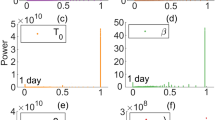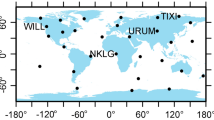Abstract
Accurate modeling of tropospheric delays is crucial for the global navigation satellite system (GNSS), which finds extensive applications in early warning systems of natural hazards and extreme weather forecasting. Zenith tropospheric delay (ZTD) is estimated as a random walk process with a constraint in GNSS processing. The constraint, referred to as random walk process noise (RWPN), holds significant importance in real-time ZTD estimation and exhibits geographical and temporal specificity. Presently, RWPN is treated as either a constant value or derived from a numerical weather model (NWM). To address this, our study presents a global RWPN model (GRM) by parameterizing a decade of NWM-derived RWPN data. Taking into account its spatiotemporal nature, we formulate the RWPN equation for each station by employing trigonometric, exponential, and Legendre functions. The optimum RWPN value is determined by incorporating GRM using latitude, longitude, orthometric height, and time as inputs. To validate the efficacy of GRM, we compare its performance against RWPN values derived from both JRA-55 and ERA5 datasets for the year 2020. The results indicate that the GRM-derived values exhibit enhanced accuracy in comparison with the optimal fixed RWPN values, as well as the yearly and monthly mean RWPN values. Additionally, we assess the efficacy of the GRM model in real-time ZTD estimation across 20 globally distributed GNSS stations. The results reveal an improvement exceeding 10% when compared to the results of the best fixed RWPN values. The GRM model offers an effective solution for obtaining accurate RWPN values on a global level, all while minimizing computational demands and time constraints. This notable progress significantly bolsters the precision of real-time GNSS estimates, thus facilitating their application in time-sensitive geophysical and meteorological scenarios.
Highlights
A global RWPN model is introduced for real-time GNSS tropospheric delay estimation. The model provides precise RWPN values while minimizing computation cost and time. The proposed model improves the accuracy of real-time ZTD estimation by over 10%. This model promotes GNSS in time-critical geophysical applications.









Similar content being viewed by others
Data Availability
We would like to thank Dr. Florian Zus for the ERA5 data-derived GFZ-VMF1 product (https://cds.climate.copernicus.eu/cdsapp#!/dataset/10.24381/cds.bd0915c6? tab = overview), International GNSS Service (IGS) for providing the GNSS observations, and final tropospheric products (https://cddis.nasa.gov/archive/gnss/products/troposphere /zpd/), Centre National d’Études Spatiales (CNES) for providing real-time orbit and clock products (http://www.ppp-wizard.net/products/REAL_TIME/). The model proposed in this study and the output results are hosted within the Zenodo repository (https://zenodo.org/record/6967015#.Yu0IrnZBxD8).
References
Ahrens CD (2015) Meteorology today: an introduction to weather, climate, and the environment. Cengage Learning Canada Inc, Toronto
Benjamin SG, Jamison BD, Moninger WR, Sahm SR, Schwartz BE, Schlatter TW (2010) Relative short-range forecast impact from aircraft, profiler, radiosonde, VAD, GPS-PW, METAR, and mesonet observations via the RUC hourly assimilation cycle. Mon Weather Rev 138(4):1319–1343
Bharucha-Reid AT (1997) Elements of the theory of Markov processes and their applications. Courier Corporation, Massachusetts
Black HD (1978) An easily implemented algorithm for the tropospheric range correction. J Geophys Res: Solid Earth 83(B4):1825–1828
Boehm J, Kouba J, Schuh H (2009) Forecast Vienna Mapping Functions 1 for real-time analysis of space geodetic observations. J Geod 83(5):397–401
Böhm J, Schuh H (2013) Atmospheric effects in space geodesy, vol 5. Springer, Berlin
Böhm J, Niell A, Tregoning P, Schuh H (2006) Global Mapping Function (GMF): a new empirical mapping function based on numerical weather model data. Geophys Res Lett 33(7):L07304
Böhm J, Heinkelmann R, Schuh H (2007) Short note: a global model of pressure and temperature for geodetic applications. J Geod 81(10):679–683
Bonafoni S, Biondi R, Brenot H, Anthes R (2019) Radio occultation and ground-based GNSS products for observing, understanding and predicting extreme events: a review. Atmos Res 230:104624
Cui B, Wang J, Li P, Ge M, Schuh H (2022) Modeling wide-area tropospheric delay corrections for fast PPP ambiguity resolution. GPS Solut 26(2):56
Dousa J, Elias M (2014) An improved model for calculating tropospheric wet delay. Geophys Res Lett 41(12):4389–4397
Farah A (2011) Assessment of UNB3M neutral atmosphere model and EGNOS model for near-equatorial-tropospheric delay correction. J Geomat 5:67–72
Gendt G, Dick G, Reigber C, Tomassini M, Liu Y, Ramatschi M (2004) Near real time GPS water vapor monitoring for numerical weather prediction in Germany. J Meteorol Soc Jpn Ser II 82(1B):361–370. https://doi.org/10.2151/jmsj.2004.361
Hadas T, Teferle FN, Kazmierski K, Hordyniec P, Bosy J (2017) Optimum stochastic modeling for GNSS tropospheric delay estimation in real-time. GPS Solut 21(3):1069–1081
Hartmann DL, Michelsen ML (1993) Large-scale effects on the regulation of tropical sea surface temperature. J Clim 6(11):2049–2062
Hersbach H, Bell B, Berrisford P, Hirahara S, Horányi A, Muñoz-Sabater J, Nicolas J, Peubey C, Radu R, Schepers D (2020) The ERA5 global reanalysis. Q J R Meteorol Soc 146(730):1999–2049. https://doi.org/10.1002/qj.3803
Hopfield H (1969) Two-quartic tropospheric refractivity profile for correcting satellite data. J Geophys Res 74(18):4487–4499
Hordyniec P, Bosy J, Rohm W (2015) Assessment of errors in precipitable water data derived from global navigation satellite system observations. J Atmos Solar-Terr Phys 129:69–77
Kobayashi S, Ota Y, Harada Y, Ebita A, Moriya M, Onoda H, Onogi K, Kamahori H, Kobayashi C, Endo H (2015) The JRA-55 reanalysis: general specifications and basic characteristics. J Meteorol Soc Jpn Ser II 93(1):5–48
Kouba J (2008) Implementation and testing of the gridded Vienna Mapping Function 1 (VMF1). J Geod 82(4–5):193–205
Kouba J, Héroux P (2001) Precise point positioning using IGS orbit and clock products. GPS Solut 5(2):12–28
Landskron D, Böhm J (2018) VMF3/GPT3: refined discrete and empirical troposphere mapping functions. J Geod 92(4):349–360. https://doi.org/10.1007/s001
Larson KM, Lay T, Yamazaki Y, Cheung KF, Ye L, Williams SD, Davis JL (2021) Dynamic sea level variation from GNSS: 2020 Shumagin earthquake tsunami resonance and Hurricane Laura. Geophys Res Lett 48(4):10. https://doi.org/10.1029/2020GL091378
Lee S-W, Kouba J, Schutz B, Kim DH, Lee YJ (2013) Monitoring precipitable water vapor in real-time using global navigation satellite systems. J Geodesy 87(10–12):923–934
Li X, Dick G, Lu C, Ge M, Nilsson T, Ning T, Wickert J, Schuh H (2015a) Multi-GNSS meteorology: real-time retrieving of atmospheric water vapor from BeiDou, Galileo, GLONASS, and GPS observations. IEEE Trans Geosci Remote Sens 53(12):6385–6393
Li X, Zus F, Lu C, Dick G, Ning T, Ge M, Wickert J, Schuh H (2015b) Retrieving of atmospheric parameters from multi-GNSS in real time: validation with water vapor radiometer and numerical weather model. J Geophys Res: Atmos 120(14):7189–7204
Li X, Han X, Li X, Liu G, Feng G, Wang B, Zheng H (2021) GREAT-UPD: An open-source software for uncalibrated phase delay estimation based on multi-GNSS and multi-frequency observations. GPS Solut 25(2):1–9
Lu C, Li X, Nilsson T, Ning T, Heinkelmann R, Ge M, Glaser S, Schuh H (2015) Real-time retrieval of precipitable water vapor from GPS and BeiDou observations. J Geodesy 89(9):843–856
Lu C, Zhong Y, Wu Z, Zheng Y, Wang Q (2023) A tropospheric delay model to integrate ERA5 and GNSS reference network for mountainous areas: application to precise point positioning. GPS Solut 27(2):81
Lühr H, Maus S (2010) Solar cycle dependence of quiet-time magnetospheric currents and a model of their near-Earth magnetic fields. Earth Planets Space 62(10):843–848
Penna N, Dodson A, Chen W (2001) Assessment of EGNOS tropospheric correction model. J Navig 54(1):37–55
Petit G, Luzum B (2010) IERS Conventions (2010) IERS Tech Note 36. Verlag des Bundesamtes für Geodäsie und Kartographie, Frankfurt am Main
Phinney RA, Burridge R (1973) Representation of the elastic-gravitational excitation of a spherical earth model by generalized spherical harmonics. Geophys J Int 34(4):451–487
Putri N, Landskron D, Böhm J (2020) Assessing the performance of Vienna mapping functions 3 for GNSS stations in Indonesia using precise point positioning. Adv Geosci 50:77–86
Ratnam DV, Dabbakuti JK, Sunda S (2017) Modeling of ionospheric time delays based on a multishell spherical harmonics function approach. IEEE J Sel Top Appl Earth Observ Remote Sens 10(12):5784–5790
Saastamoinen J (1972) Atmospheric correction for the troposphere and stratosphere in radio ranging satellites. Use Artif Satell Geod 15(3):247–251. https://doi.org/10.1029/GM015p0247
Schuler T (2001) On ground-based GPS tropospheric delay estimation. Doctor's thesis, Studiengang Geodsie und Geoinformation, Universitt der Buundeswehr Munchen
Shi G, Huang B, Leung AK, Ng CW, Wu Z, Lin H (2022) Millimeter slope ratcheting from multitemporal SAR interferometry with a correction of coastal tropospheric delay: a case study in Hong Kong. Remote Sens Environ 280:113148
Steigenberger P, Boehm J, Tesmer V (2009) Comparison of GMF/GPT with VMF1/ECMWF and implications for atmospheric loading. J Geodesy 83:943–951
Trenberth KE, Stepaniak DP (2003) Seamless poleward atmospheric energy transports and implications for the Hadley circulation. J Clim 16(22):3706–3722
Tsushima H, Ohta Y (2014) Review on near-field tsunami forecasting from offshore tsunami data and onshore GNSS data for tsunami early warning. J Disaster Res 9(3):339–357
Wang J, Chen J, Wang J (2014) Analysis of tropospheric propagation delay mapping function models in GNSS. Progr Astron 32(3):383–394
Wang WuZ, Maximilian S, Zus F, Gerland S, Ramatschi M, Ge M, Wickert J, Schuh AH (2019) Retrieving Precipitable Water Vapor From Shipborne Multi-GNSS Observations. Geophys Res Lett 46(9):5000–5008. https://doi.org/10.1029/2019GL082136
Wu J-T, Wu SC, Hajj GA, Bertiger WI, Lichten SM (1993) Effects of antenna orientation on GPS carrier phase. Manuscr Geodaet 18(2):91–98
Wu Z, Liu Y, Liu Y, Lu C, He X, Jin K, Xu W (2022) Rapid calibration of HY-2A satellite-borne microwave radiometer using coastal GNSS observations. J Geodesy 96(4):1–13. https://doi.org/10.1007/s00190-022-01617-w
Wu Z, Liu Y, Liu Y, Wang J, He X, Xu W, Ge M (2021) Calibrating the Haiyang-2A calibration microwave radiometer when the 18.7-GHz band fails. IEEE Trans Geosci Remote Sens. 12:1587-1598 https://doi.org/10.1109/TGRS.2021.3073278
Zhang H, Yuan Y, Li W, Zhang B (2019) A real-time precipitable water vapor monitoring system using the national GNSS network of China: Method and preliminary results. IEEE J Sel Top Appl Earth Observ Remote Sens 12(5):1587–1598
Zus F, Dick G, Douša J, Heise S, Wickert J (2014) The rapid and precise computation of GPS slant total delays and mapping factors utilizing a numerical weather model. Radio Sci 49(3):207–216
Acknowledgements
This research is financially supported by the National Natural Science Foundation of China (42204018, 41974029) and the National Key R&D Program of China (2021YFC3000504), the State Key Laboratory of Geodesy and Earth’s Dynamics, Innovation Academy for Precision Measurement Science and Technology, CAS, China (Grant SKLGED2022-3-8). The numerical calculations in this paper have been done on the supercomputing system in the Supercomputing Center of Wuhan University.
Author information
Authors and Affiliations
Contributions
ZW and CL proposed this study and developed the methodology. YT, YZ, and YL conducted the experiments for data collection and processing. ZW and CL wrote the manuscript. YL and KJ edited the manuscript. All authors were involved in discussions and provided critical feedback to the manuscript.
Corresponding author
Ethics declarations
Conflict of interest
The authors have no conflicts of interest to declare that are relevant to the content of this article.
Rights and permissions
Springer Nature or its licensor (e.g. a society or other partner) holds exclusive rights to this article under a publishing agreement with the author(s) or other rightsholder(s); author self-archiving of the accepted manuscript version of this article is solely governed by the terms of such publishing agreement and applicable law.
About this article
Cite this article
Wu, Z., Lu, C., Tan, Y. et al. Real-time GNSS tropospheric delay estimation with a novel global random walk processing noise model (GRM). J Geod 97, 112 (2023). https://doi.org/10.1007/s00190-023-01780-8
Received:
Accepted:
Published:
DOI: https://doi.org/10.1007/s00190-023-01780-8




